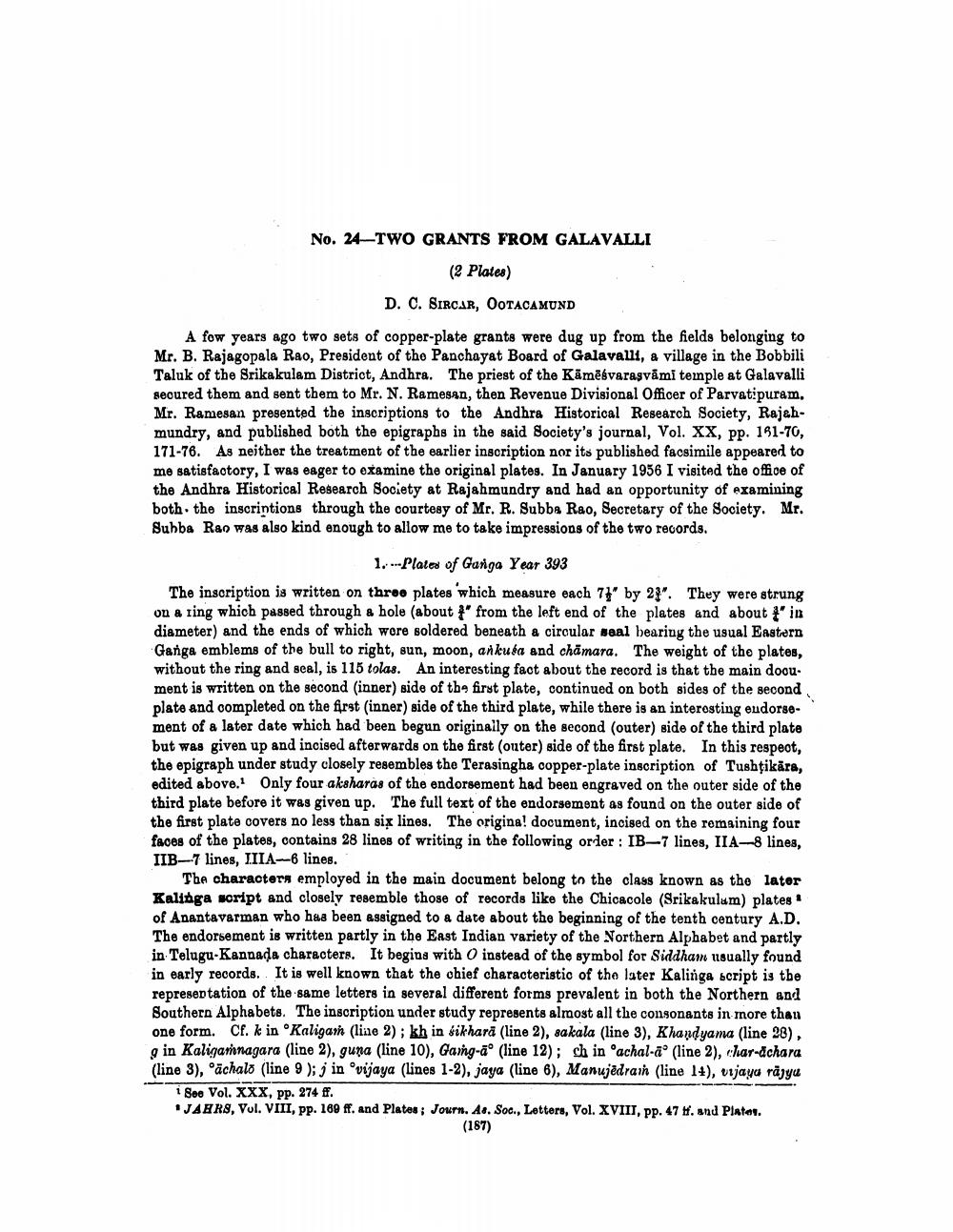________________
No. 24-TWO GRANTS FROM GALAVALLI
(2 Plates)
D. C. SIRCAR, OOTACAMUND
A fow years ago two sets of copper-plate grants were dug up from the fields belonging to Mr. B. Rajagopala Rao, President of the Panchayat Board of Galavalli, a village in the Bobbili Taluk of the Srikakulam District, Andhra. The priest of the Kāmēbvaragvåmi teinple at Galavalli secured them and sent them to Mr. N. Ramesan, then Revenue Divisional Officer of Parvatipuram, Mr. Ramesan presented the inscriptions to the Andhra Historical Research Society, Rajahmundry, and published both the epigraphs in the said Society's journal, Vol. XX, pp. 161-70, 171-76. As neither the treatment of the earlier inscription nor its published facsimile appeared to me satisfactory, I was eager to examine the original plates. In January 1956 I visited the office of the Andhra Historical Research Society at Rajahmundry and had an opportunity of examining both the inscrintions through the courtesy of Mr. R. Subba Rao, Secretary of the Society. Mr. Subba Rao was also kind enough to allow me to take impressions of the two records.
1. Plates of Ganga Year 393 The inscription is written on three plates which measure each 71' by 2)". They were strung on a ring which passed through a hole (about f" from the left end of the plates and about t" in diameter) and the ends of which were soldered beneath a circular seal bearing the usual Eastern Ganga emblems of the bull to right, sun, moon, ankuta and chämara. The weight of the plates, without the ring and seal, is 115 tolas. An interesting fact about the record is that the main doou. ment is written on the second (inner) side of the first plate, continued on both sides of the second plate and completed on the first (inner) side of the third plate, while there is an interosting endorsement of a later date which had been begun originally on the second (outer) side of the third plate but was given up and incised afterwards on the first (outer) side of the first plate. In this respect, the epigraph under study closely resembles the Terasingha copper-plate inscription of Tushţikära, edited above. Only four aksharas of the endorsement had been engraved on the outer side of the third plate before it was given up. The full text of the endorsement as found on the outer side of the first plate covers no less than six lines. The original document, incised on the remaining four faces of the plates, contains 28 lines of writing in the following order : IB-7 lines, IIA-8 lines, IIB-7 lines, IIIA-6 lines.
The characters employed in the main document belong to the class known as the lator Kalaga soript and closely resemble those of records like the Chicacole (Srikakulum) plates of Apantavarman who has been assigned to a date about the beginning of the tenth century A.D. The endorsement is written partly in the East Indian variety of the Northern Alphabet and partly in Telugu-Kannada characters. It begins with O instead of the symbol for Siddham usually found in early records. It is well known that the chief characteristic of the later Kalinga script is the representation of the same letters in several different forms prevalent in both the Northern and Southern Alphabets. The inscription under study represents almost all the consonants in more than one form. Cf. k in Kaligan (line 2); kh in sikhara (line 2), sakala (line 3), Khandyama (line 28), o in Kaligannagara (line 2), guna (line 10), Gang-ão (line 12); ch inachal-a' (line 2), char-achara (line 3). "achalo (line 9 ); in vijaya (lines 1-2), jaya (line 6), Manujēdrain (line 14), vijaya rayu
i Sve Vol. XXX, pp. 274 ff. *JAHRS, Vol. VIII, pp. 169 ff. and Plates; Journ. As. Soc., Letters, Vol. XVIIT, PP. 47 H. and Plates.
(187)




